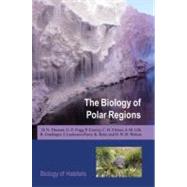
Note: Supplemental materials are not guaranteed with Rental or Used book purchases.
Purchase Benefits
What is included with this book?
| Preface | p. vii |
| Introduction to the polar regions | p. 1 |
| Introduction | p. 1 |
| The energy balances of the polar regions | p. 2 |
| Climate | p. 17 |
| Thermohaline circulation | p. 22 |
| El Nino Southern Oscillation | p. 23 |
| Arctic and North Atlantic Oscillations | p. 25 |
| Magnetic and electrical phenomena | p. 26 |
| Stress, adaptation, and survival in polar regions | p. 28 |
| Introduction | p. 28 |
| Life at low temperatures | p. 30 |
| Desiccation | p. 39 |
| The effects of radiation | p. 42 |
| Biological rhythms in the polar environment | p. 49 |
| Periglacial and terrestrial habitats in polar regions | p. 53 |
| Introduction | p. 53 |
| Substrata | p. 54 |
| Communities | p. 65 |
| The physiological ecology of polar plants and invertebrates | p. 90 |
| Specialized communities | p. 92 |
| Comparison of Arctic and Antarctic terrestrial habitats and communities | p. 97 |
| Glacial habitats in polar regions | p. 101 |
| Introduction | p. 101 |
| Life in the interior of polar ice sheets and glaciers | p. 102 |
| Life at the margin | p. 107 |
| The snow alga community | p. 112 |
| Wider perspectives | p. 115 |
| Inland waters in polar regions | p. 116 |
| Introduction | p. 116 |
| Arctic lakes | p. 118 |
| Antarctic lakes | p. 125 |
| Streams and rivers | p. 139 |
| Conclusions | p. 142 |
| Open oceans in polar regions | p. 143 |
| Introduction | p. 143 |
| Gradients in waters | p. 143 |
| The plankton | p. 146 |
| The physiological ecology of polar phytoplankton | p. 154 |
| The zooplankton | p. 165 |
| Squid | p. 172 |
| Fish | p. 173 |
| The polar marine pelagic systems | p. 175 |
| Frozen oceans in polar regions | p. 179 |
| Introduction | p. 179 |
| The physical characteristics of sea ice | p. 180 |
| The biology of sea ice | p. 192 |
| The ice edge | p. 209 |
| Polynyas | p. 213 |
| The wider significance of sea ice biology | p. 214 |
| Marine benthos in polar regions | p. 220 |
| Introduction | p. 220 |
| The littoral zone | p. 222 |
| The shallow sublittoral zone | p. 226 |
| The benthos of deep waters | p. 244 |
| Benthos under ice shelves | p. 246 |
| Seasonality and dynamics of benthic communities | p. 248 |
| Comparisons and conclusions | p. 254 |
| Birds and mammals in polar regions | p. 259 |
| Introduction | p. 259 |
| Seabirds | p. 259 |
| Seals | p. 270 |
| Whales | p. 277 |
| Bears and foxes | p. 280 |
| Climate change in polar regions | p. 284 |
| Introduction | p. 284 |
| Changes during geological time: the ice ages | p. 285 |
| Biological responses to long-term changes | p. 287 |
| Present-day global climate change and polar regions | p. 295 |
| Human impact on polar regions | p. 301 |
| The first invasions by humans | p. 301 |
| The ecology of pre-industrial humans in the Arctic | p. 302 |
| Sealing and whaling | p. 303 |
| Hunting | p. 307 |
| Fishing | p. 308 |
| Pastoral and agriculture development | p. 311 |
| Introduction of non-native organisms by humans | p. 314 |
| Mineral and oil extraction | p. 316 |
| Pollution | p. 320 |
| Tourism | p. 323 |
| Military uses of the polar regions | p. 326 |
| Conservation | p. 327 |
| Some conclusions | p. 332 |
| Further reading and web resources | p. 338 |
| References | p. 344 |
| Index | p. 377 |
| Table of Contents provided by Ingram. All Rights Reserved. |
The New copy of this book will include any supplemental materials advertised. Please check the title of the book to determine if it should include any access cards, study guides, lab manuals, CDs, etc.
The Used, Rental and eBook copies of this book are not guaranteed to include any supplemental materials. Typically, only the book itself is included. This is true even if the title states it includes any access cards, study guides, lab manuals, CDs, etc.